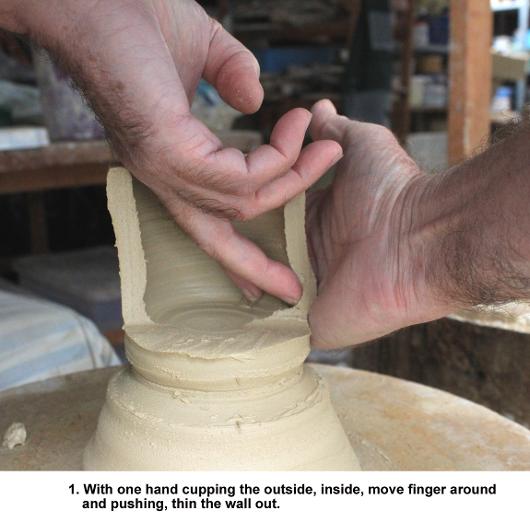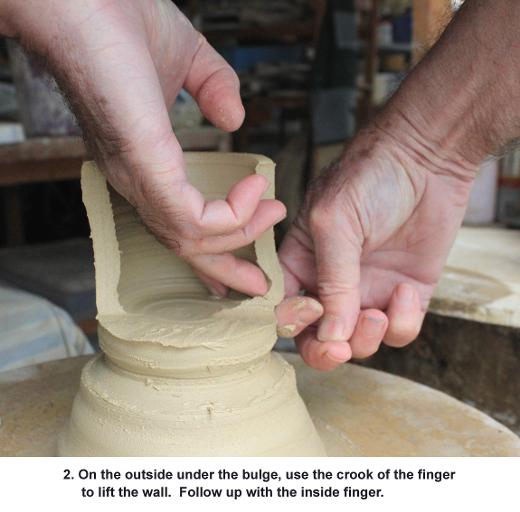Hand crafted pottery wares in the traditional style for ordinary domestic use.
WHAT THIS MEANS:
HANDMADE: Terracotta, Earthenware, Stoneware or Porcelain clay, glazed, decorated or plain, wheel thrown, and hand-built. Fired in a kiln.
CRAFTSPERSON: Made by a potter, or potters, amateur, hobbyist, artisan or professional, artist craftsperson, in a small scale operation, like a home workshop, studio or cottage industry. Not pottery made by an industrial manufacturing process in a factory or industrial operation.
FUNCTIONAL: Serviceable, utilitarian, functional wares normally found in daily use in the home.
FORMS: Typical forms are cups, saucers, mugs, bowls, plates, platters, jugs, teapots, lidded bowls, lidded containers, bread crocks, vases, casseroles, colanders, steamer pots, lidded storage vessels, cook and bake pottery wares, oil burners, flower pots and trays, etc.
EXCEPTION: Some things which might not be suitable in this category are religious, devotional, or iconic pieces, very big vessels which were made for ceremonial, commercial, industrial, and formal or prestigious use, like large urns, very large bowls and platters, very large vases.
ART: Obvious extreme variations to the form of the standard utilitarian wares for personal expression, for embellishment, for artistry, are immediately not within the scope of pottery considered here to be in a traditional style. The use of extraordinary construction, materials, shaping or sizing of otherwise normal home wares, renders them art objects.
WARES: Pottery wares does not include art objects, figurines, sculpture, or wares not functional or made representational, not actual. Some items of a special nature such as Raku, are not for ordinary use. There are other wares which are perfectly good, like Majolica, but not strictly food safe.
SAFE: The domestic pottery wares, being serviceable, utilitarian, functional wares normally found in daily use in the home, would be pottery clay fired to a high temperature approx. 1120C to 1280C , with or without decoration and glaze, not be unhygienic or unsafe to use, not difficult to clean, not too fragile, nor easily damaged, and perform an intended utilitarian function well.
民芸陶器 Mingei - touki and 小代焼 Shoudaiyaki.
The term mingei, 民芸 (folk art) was coined by Yanagi Soetsu (1889-1961) in 1926 to refer to common crafts that had been brushed aside and overlooked by the industrial revolution. Yanagi's book "The Unknown Craftsman" has since become a classic. Mingei is an abbreviation of “minshu-teki kogei” which means “hand-crafted art of ordinary people.” The Mingei products are mostly ordinary and utilitarian objects.
In
the wake of the great tide of industrialism in the early part of the
last century, something of the human touch and spirit was lost in
everyday articles of use. It was with a sense of urgency that Yanagi
and his lifelong companions, the potters Bernard Leach, Hamada Shoji,
Tomimoto Kenkichi (who later left the Mingei group) and Kawai Kanjiro
sought to counteract the desire for cheap, mass-produced products by
pointing to the works of ordinary craftsmen that spoke to the
spiritual and practical needs of life. The mingei movement is
responsible for keeping alive many traditions.
Another style
that can be grouped with Mingei is Shodai-yaki, 小代焼.
Shodai employs iron-rich clay, over which a dark brown iron glaze is
applied, and then over it rice-straw ash-glaze is either ladled or
dramatically dripped on. It is also referred to as Koshiro-yaki
Made from a local iron rich clay, a particular feature of this ware is its bold and yet simple rustic character. By modifying the blend of glazes and by utilizing the changes which take place at different firing temperatures, delicate control is exercised over the production of colors for the blue, yellow and white Shodai-yaki. In addition, the dribbled, extravagant patterns and the depth of color of the glazes harmonize with the forms of the pieces, to produce this sense of bold simplicity.
(mostly from The Robert Yellin Yakimono Gallery)
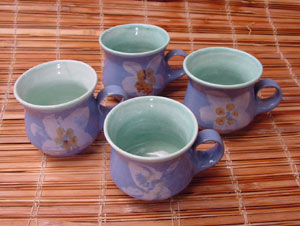
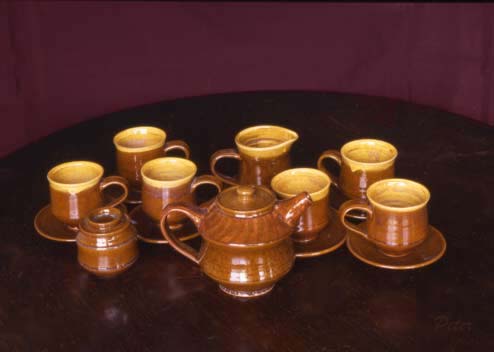
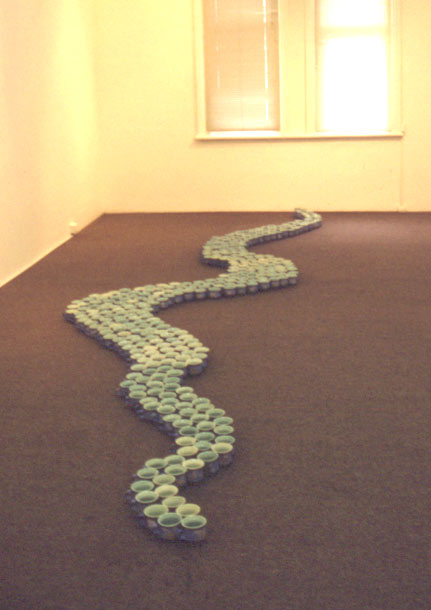
BACKGROUND NOTES:
- The word traditional is used to define the time honored, long-established, domestic pottery shapes and forms and the process of manufacture. It does not mean a psychological conformity or limitation of skill and ability for the potter.
- In drawing attention to the small scale maker of domestic utilitarian pottery, the local maker of pottery, it is not prescribing design, aesthetic direction or purpose, or industry development, good or bad.
- The understanding of what kind of pottery this may refer to, is not limited to what I have described. Essentially it is about the hand-maker, and anyone is open to make a contribution.
- The emphasis for this kind of pottery is not intended to be comparative, nor exclusive. It is looking only at this pottery in particular, for its merits. General schemes and broad perceptions, which take in the many and diverse, invariably do not see the relevance or merit of actually working attentively as the individual craftsperson.
- The craft potter may want to express themselves as amateur, because it is a love of craft production, and not merely commercial, but this should not be thought of as unskilled, unprofessional, or without high standards.
A technique for lifting the wall of the pot.
When throwing, lifting the wall of the pot, is very difficult to get right. One way I was shown which made it much easier, was after the basic form is thrown, place the finger inside and thin out the wall at the base, wiggling the finger at one point. Right from the start, thin it out as thin as you want the wall to be in the end product. On the outside using the crook of the finger placed under the bulging ridge, get a feel for the clay with the finger under the ridge, and feel the motion of the turning clay running over the crooked finger. It is not so much as lifting as moving upwards with the ridge running ahead. You can repeat this, while an experienced potter can do it in one. It may be that you come up a short distance, and restart from this new point.
